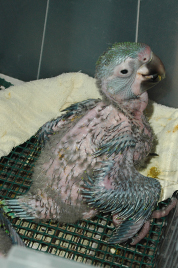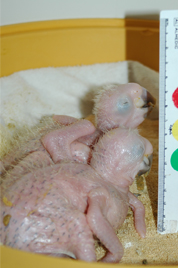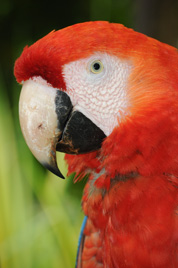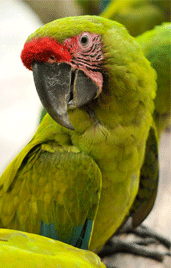
The Macaw Sanctuary El Manantial is a project dedicated to the conservation of macaws native to Costa Rica. The main focus of the project is the Scarlet Macaw (Ara macao) and the Great Green Macaw (Ara Ambiguus), who once flew freely in many areas of Costa Rica. In 1994, individuals concerned with the status of these endangered species decided to create a project for their conservation; with the sole purpose of the project being the reintroducing of Macaws back into the wild, striving to increase their population numbers.
As a result of practices such as the destruction of habitat, logging of the Almendro de Montaña (Dipteryx panamensis) trees and the poaching of macaw chicks for sale in the pet trade, the specie’s population has become severely reduced. Both species are listed as endangered in Costa Rica, listed under Appendix I of CITES (the Convention on International Trade in Endangered Species).
At this moment in time there are estimated to be less than 40 breeding pairs of Great Green Macaws in all of Costa Rica. Although the Scarlet Macaw is more numerous, it is now only possible to see them in isolated parts of the country, with the largest population being in Carara National Park.
The Sanctuary operates under the supervision of the Ministry of the Environment Energy and Telecommunication (MINAET) and in accordance with the wildlife conservation laws of Costa Rica.
The primary goal of the project is the conservation of macaws native to Costa Rica. However El Manantial works on a variety of other programs. These are:
The birds hatch to be free.
At the Sanctuary, Great Green macaws and Scarlet macaws are not bred for the pet trade.They are strictly bred in order to release their young in to the wild to be set free forever.
On the project the birds fly unrestricted, enjoying the trees and the fruits they can find around this habitat and eating clay on the ground.
 Great Green Macaw 30 days.
Great Green Macaw 30 days.  Great Green Macaw 12 days
Great Green Macaw 12 days
Aranjuez is an important Village for the liberation program; the people of this town are in charge of caring for and watching over the wild macaws.
The people in Aranjuez are now understanding to appreciate nature more while learning at the same time that the macaws are more valuable being free than trapped inside a cage.
Scarlet Macaw (Ara macao)

One of the most eye-catching and stunning birds of Costa Rica is the endangered Scarlet Macaw. This colorful parrot at one point had populated around 80% of Costa Rica, but their population has been diminished so greatly that they now only live in about 20% of the country. Its range of habitat includes dry, moist and wet tropical lowland forest, which depicts the vast range of habitat in which they are able to survive in.
Great Green Macaw (Ara ambiguus)

The ara ambiguus has a limited distribution in the Atlantic wet lowlands of Central America. In Costa Rica, this species is currently limited to the Northern Zone, more specifically to the area between the San Carlos, San Juan, and Sarapiquí rivers extending to the northern foothills of the Central Volcanoes Range. It highly depends on the almendro tree (Dipteryx panamensis) both for feeding and nesting substrate. This species is listed in Appendix I of CITES, which means that it is endangered.